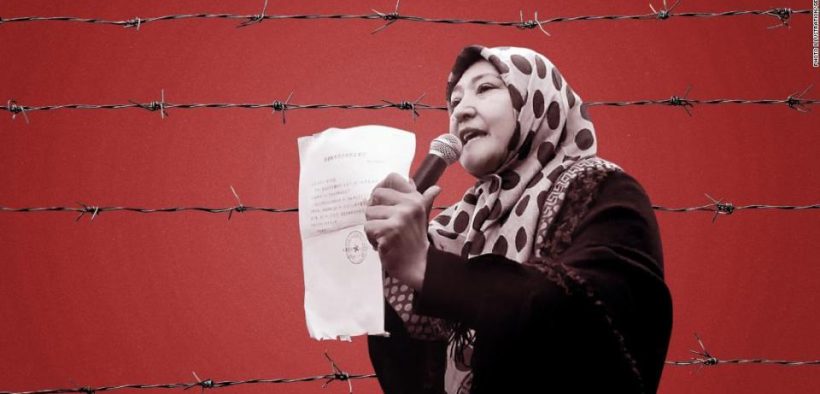A former resident of Urumqi, the capital of China’s western Xinjiang region, the 38-year-old Uyghur woman said she was fined 18,400 yuan ($2,600) in 2018 for having three children, one more than she was allowed to under Chinese rule.
When she went to pay the fine, Dawut said she was told she’d also need to have a mandatory “birth control procedure.”
She said she was taken to a clinic, where she was hooked up to an IV and given a general anesthetic. A local doctor later told her she’d undergone a tubal ligation, a procedure that uses keyhole surgery to clip, cut or tie a woman’s fallopian tubes.
The doctor said the procedure was permanent — she wouldn’t be able to have any more children.
Dawut’s story is not unique. For years, Uyghur women both inside Xinjiang and around the world have accused the Chinese government of a campaign of abuse, including forced sterilization, cultural indoctrination and incidents of sexual violence.
It’s part of a wider pattern of human rights violations by the Chinese Communist Party in Xinjiang, where authorities are accused of detaining
up to two million Muslim-majority Uyghurs and other minority ethnic groups inside vast, fortified centers as part of efforts to enforce greater control over the region.
Rahima Mahmut, a Xinjiang exile and project director for the World Uyghur Congress in London, said women in Xinjiang are living in “hell.”
“Just like any genocide, women are always the number one target … There is a very, very serious crime happening at such a large scale,” she said.
The Chinese government has consistently denied all allegations, presenting its efforts in Xinjiang as legal and necessary measures to prevent extremism, and has used a series of what state-run media refers to as terrorist attacks in 2014 and 2015 to justify its crackdown.
It has also attempted to discredit Dawut’s account specifically, with the state-owned newspaper the Global Times quoting claims from her own brother that she’s “peddling lies online.”
CNN has reached out to the local Xinjiang government for comment.
Crackdown on women
Beijing has a history of policing women’s reproductive rights as part of
the “one-child policy,” a mass campaign to slow birth rates in China. From its introduction in 1980, the policy officially saw
400 million births “prevented,” amid reports of state-enforced abortions and mandatory contraception.
The one-child policy was changed to allow two children in 2015 amid a rapidly-shrinking birth rate. In Xinjiang, rural couples are allowed to have
up to three children, which authorities claim is out of respect for ethnic minorities’
cultural traditions of large families.Now
a new report, titled “The (Chinese Communist Party’s) campaign to suppress Uyghur birthrates in Xinjiang,” alleges that Beijing is trying to reduce the Uyghur population through enforced contraception and sterilizations.
It was compiled by Adrian Zenz, a leading Xinjiang scholar, and is backed up by years of witness reports and statements from women both in Xinjiang and around the world.
Xinjiang is
culturally and ethnically different from the rest of China, with a large population of Turkic minority groups who until recently
were the majority in the region. For years, the region has maintained an uneasy relationship with the government in Beijing.
But beginning in 2017, Zenz quotes official Chinese government policy directives calling on administrators to “severely attack behaviors that violate family planning (policies).” From that year onwards, minority regions began a “special campaign to control birth control violations.”
According to the report, the stricter enforcement led to increased prosecutions of birth control violators and harsher punishments.
Xinjiang accounted for 80% of new IUD insertions throughout China in 2018, according to official government records outlined in the report and confirmed by CNN. The statistics areprimarily due to a massive drop in the use of IUDs in the rest of the country, as Beijing
pushes women in the rest of China to have more children.
In Xinjiang, the opposite is happening. There, the number of sterilizations has skyrocketed, according to government records. In 2014, the year before the start of the government crackdown in Xinjiang, there were 3,214 sterilizations in the region — in 2018, there were 60,440.
In his report, Zenz claimed that as a result of these policies, the natural birth rate in parts of Xinjiang with a large Uyghur population had seen a significant decrease in population growth.
According to Zenz’s calculations, across all parts of Xinjiang predominantly populated by Turkic minorities, natural population growth dropped from more than 15% in 2014 to just over 4% in 2018.
Zenz estimated the birthrates by combining official Chinese government statistics for Xinjiang prefectures and weighting them by population. Worryingly, Zenz said that some predominantly Uyghur prefectures such as Kashgar didn’t publish their population growth rates at all in 2019.
The Global Times news outlet has claimed that Zenz’s
math is wrong, and attributed the slower population growth to increased education and income levels in Xinjiang.
In a response to the report, the Chinese government said that between 1978 and 2018, the Uyghur population in Xinjiang had grown from 5.5 million to more than 11 million.
However, Zenz claims that he has found evidence of a deliberate campaign to control Uyghur population growth that goes far beyond stricter enforcement of the two-child policy.
The report claims that Chinese authorities imposed targets for up to 80% of child-bearing women in four southern prefectures, with large Uyghur populations, to undergo “birth control measures with long-term effectiveness.”
In some cases, women had IUDs inserted after only their first child, according to Zenz’s report.
“China is trying to reduce birth rates in Xinjiang because this was a region where birth rates were the higher than the rest of the country. And in a sense it was seen to be out of control. And of course it makes the Uyghurs harder to control. The more people you have, the harder they are to account for,” Zenz said.
The report also aligns with witness testimony from Xinjiang detention centers where multiple women have described being given injections and pills which stopped their periods.
Uyghur exile Dawut said she spent about three months in a detention center from March 2018.Inside the center, she said she was forcibly given medication, after which she stopped menstruating.
CNN spoke to an ethnic Uyghur and doctor from Xinjiang, who asked to go only by her first name, Gulgine, for fear of retribution.
Gulginefled to Turkey in 2012 and set up a clinic in Istanbul in 2013. She said since then shehas examined around 300 exiled Uyghur women from Xinjiang, and almost all of them had some form of birth control. About 80 had been sterilized.
Many of the women who had been permanently sterilized told Gulgine that they didn’t know they had undergone the procedure until she told them.
Zenz said that his findings were the firmest proof yet of “genocide” in Xinjiang. “It specifically fulfills
one of the five criteria of the United Nations convention for the prevention of genocide, which is the suppression of births,” he said.
For years, women in Xinjiang have been reporting manipulation and abuse at the hands of the Chinese government.
In 2015, China banned face veils and face coverings for Xinjiang women, saying that they encouraged
“religious extremism.” At the same time, local authorities pushed women to dress in more modern outfits, emphasizing cultural garb over overtly religious clothing. Experts said the campaign was called the
“Beauty Project.”In state media, the project was described as a means of helping to support Xinjiang designers and the local clothing industry. But experts on the ground said it involved numerous actions to change the way Uyghur women looked.
“There were some instances where at checkpoints, on the street, women had long skirts or dresses cut by scissors because they were supposed to only wear pants and shirts, not have anything that would go below their waist, ostensibly because that was Islamic,” said Darren Byler, a postdoctoral research fellow at the University of Colorado who worked in Xinjiang.
When Uyghurs began to be forcibly placed into detention centers in 2016, the vast majority of the inmates were male, according to
previous research by Zenz. Large numbers of women were left to care and provide for families on their own.
When she visited the region for the last time in 2018, Elise Anderson, Senior Program Officer for Research and Advocacy at Uyghur Human Rights Project, said local women who recognized her in the street would come up and ask for news or help in hushed tones.
“There was an older woman who started whispering to me and told me that her son had been taken away and just cried as she spoke,” Anderson said.
“They’re missing important people from their lives and that is inserting grief and heaviness and an emotional burden while they’re still trying to be good enough not to get taken away to a camp themselves.”
Some of the worst injustices are alleged to have occurred inside the region’s mass detention centers, in the form of humiliation and sexual abuse. Gulbakhar Jalilova, an ethnic Uyghur from neighboring Kazakhstan and former detainee, claims she was on a business trip to Xinjiang in May 2017 when she was suddenly taken away by police and thrown into a detention center.She spent 15 months inside the camp.
Jalilova claimed she was locked inside a prison-like room with about 20 other women, sitting in two rows. She said they were forced to strip naked in the yard every 10 days and squat up and down in front of guards. Some girls were only 14 years old, she said.
Jalilova said one day she was raped by a guard. “I told him, ‘Aren’t you ashamed? Don’t you have a mother, a sister, how can you do this to me like that?’ He hit me with the electroshock prod and said, ‘You don’t look like a human’,” she said.



